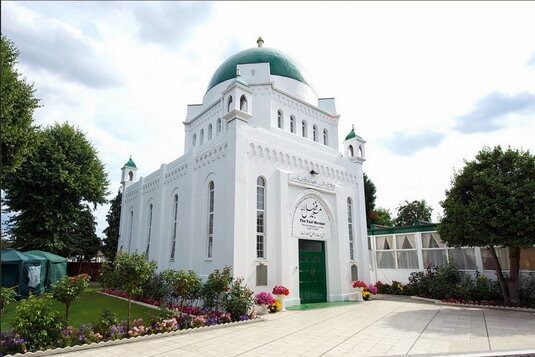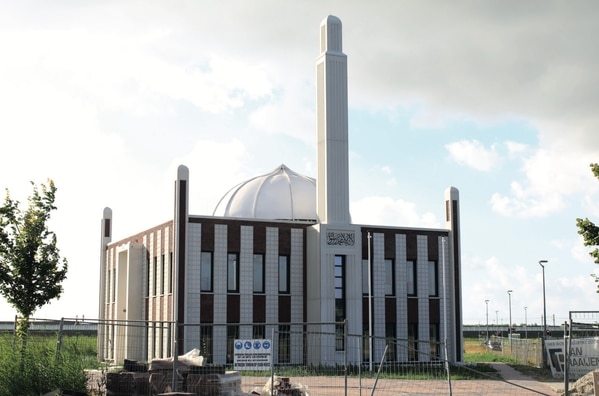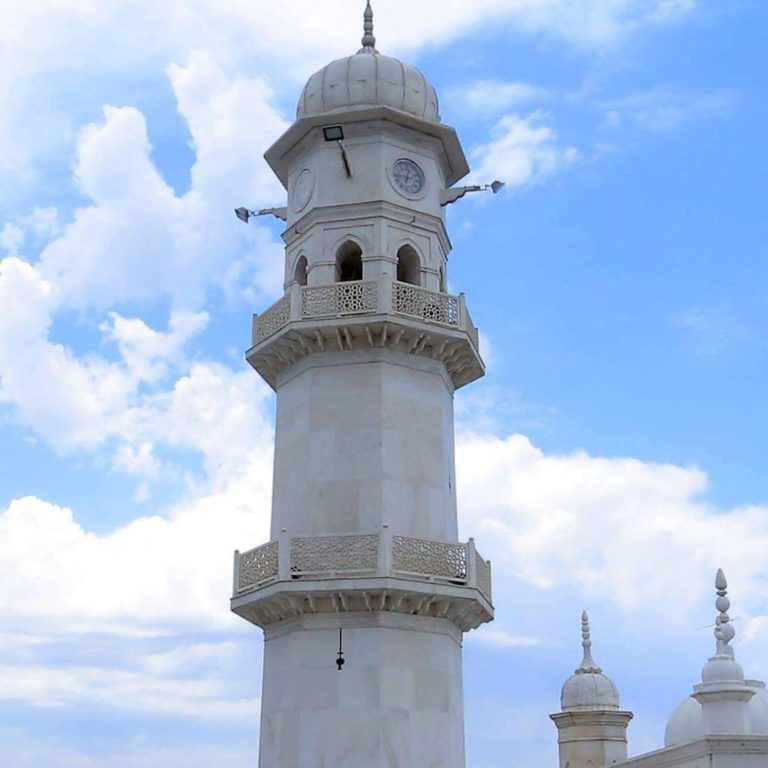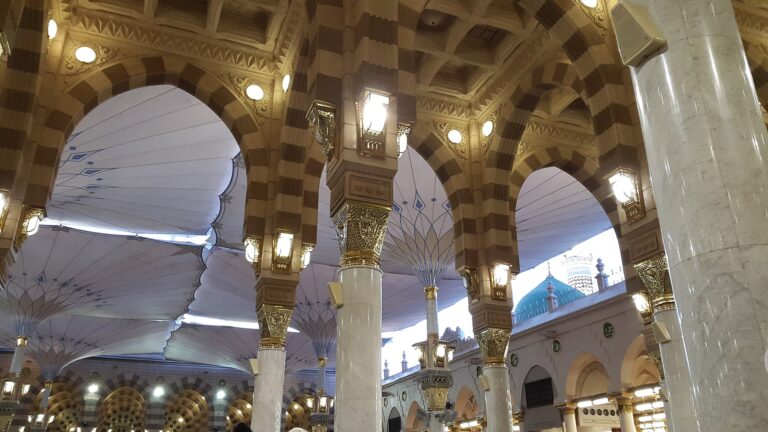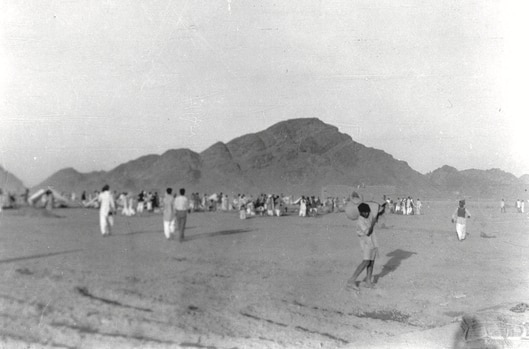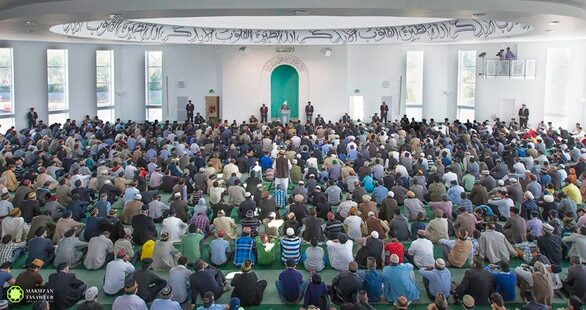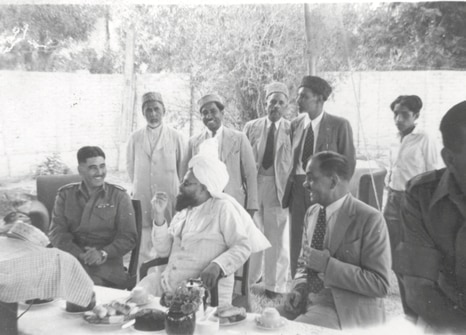Friday Sermon
15 June 2018
Important Prayers to Recite
After reciting the Tashahud, Ta‘awuz, and Surah Al-Fatihah, Hazrat Khalifatul Masih Vaa stated:
While mentioning the importance of the Friday Prayer, the Holy Prophetsa said on one occasion, “There comes such an hour on [Friday], which, if a Muslim encounters while standing in prayer, then whatever supplication they make, it is accepted, or whatever goodness they ask for, it is granted to them by God Almighty.” (Sahih Al-Bukhari, Kitab-ul-Jumu’ah, Hadith 935)
With regards to this Hadith, some people believe that the sermon delivered as part of the Friday prayer is also a part of the prayer. Hence, it is also included in that special hour which one can experience.
In any case, the Friday Prayer bears a special significance. Its observance has been made compulsory upon every male who has reached adolescence and the age of maturity, except in extreme circumstances. (Sunan Abu Dawood, Kitab-ul-Salat, Hadith 1067)
Everyone supplicates during prayers according to their own thinking and needs. There are also some, who, although offer their prayers, are not moved to make any special supplications. They simply offer the prayers, repeat the words of the prayer and consider it to be sufficient. They are unaware of the importance of prayer.
Thus, today, on this last Fridayof Ramadan, I deemed it appropriate to recite certain prayers, so that those who are not sufficiently aware may also understand the significance of prayers and so that we, as a Community, may present our prayers and supplications before God Almighty. Moreover, [in this manner we can] collectively pray for the acceptance of these supplications during the congregational prayer.
Among these prayers, I have selected some from the Holy Quran, of the Holy Prophetsa, and have also included some prayers of the Promised Messiahas. There are also some general prayers.
I will now recite some Quranic prayers and some of the prayers of the Holy Prophetsa. Those, who are familiar with these prayers, can recite them silently after me and also say “Ameen”.
May God Almighty accept our prayers.
سُبْحَانَ اللّٰهِ وَبِحَمْدِهٖ سُبْحَانَ اللّٰهِ الْعَظِيْمِ اَللّٰهُمَّ صَلِّ عَليٰ مُحَمَّدٍ و اٰلِ مُحَمَّدٍ
Firstly, there are the prayers from the Holy Quran:
رَبَّنَآ اٰتِنَا فِي الدُّنْيَا حَسَنَةً وَّفِي الْاٰخِرَةِ حَسَنَةً وَّقِنَا عَذَابَ النَّارِ
“Our Lord, grant us good in this world as well as good in the world to come, and protect us from the torment of the Fire.” (The Holy Quran, 2:202)
رَبَّنَآ اَفْرِغْ عَلَيْنَا صَبْرًا وَّتَوَفَّنَا مُسْلِمِينَ
“Our Lord, pour forth upon us steadfastness and cause us to die resigned unto Thee.” (The Holy Quran, 7:127)
اَللّٰهُمَّ رَبَّنَآ اَنْزِلْ عَلَيْنَا مَآئِدَةً مِّنَ السَّمَآءِ تَكُونُ لَنَا عِيدًا لِّاَوَّلِنَا وَاٰخِرِنَا وَاٰيَةً مِّنْكَ وَارْزُقْنَا وَاَنْتَ خَيرُ الرّٰزِقِينَ
“Our Lord, send down to us a table from heaven spread with food that it may be to us a festival, to the first of us and to the last of us, and a Sign from Thee; and provide sustenance for us, for Thou art the Best of sustainers.” (The Holy Quran, 5:115)
رَبَّنَآ اِنَّنَا سَمِعْنَا مُنَادِيًا يُّنَادِيْ لِلْاِيمَانِ اَنْ اٰمِنُوْا بِرَبِّكُمْ فَاٰمَنَّا۔ رَبَّنَا فَاغْفِرْ لَنَا ذُنُوْبَنَا وَكَفِّرْ عَنَّا سَيِّاٰتِنَا وَتَوَفَّنَا مَعَ الْاَبْرَارِ
“Our Lord, we have heard a Crier calling us unto faith, ‘Believe ye in your Lord,’ and we have believed. Our Lord, forgive us, therefore, our errors and remove from us our evils, and in death number us with the righteous.” (The Holy Quran, 3:194)
رَبَّنَآ اٰمَنَّا بِمَآ اَنْزَلْتَ وَاتَّبَعْنَا الرَّسُولَ فَاكْتُبْنَا مَعَ الشّٰهِدِينَ
“Our Lord, we believe in that which Thou hast sent down and we follow this Messenger. So write us down among those who bear witness.” (The Holy Quran, 3:54)
رَبَّنَا لَا تُزِغْ قُلُوْبَنَا بَعْدَ اِذْ هَدَيْتَنَا وَهَبْ لَنَا مِنْ لَّدُنْكَ رَحْمَةً اِنَّكَ اَنْتَ الْوَهَّابُ
“Our Lord, let not our hearts become perverse after Thou hast guided us; and bestow on us mercy from Thyself; surely, Thou alone art the Bestower.” (The Holy Quran, 3:9)
رَبِّ هَبْ لِيْ مِنْ لَّدُنْكَ ذُرِّيَّةً طَيِّبَةً إِنَّكَ سَمِيعُ الدُّعَآءِ
“My Lord, grant me from Thyself pure offspring; surely, Thou art the Hearer of prayer.” (The Holy Quran, 3:39)
رَبَّنَا هَبْ لَنَا مِنْ اَزْوَاجِنَا وَذُرِّيّٰتِنَا قُرَّةَ أَعْيُنٍ وَّاجْعَلْنَا لِلْمُتَّقِيْنَ اِمَامًا
“Our Lord, grant us of our wives and children the delight of our eyes, and make us a model for the righteous.” (The Holy Quran, 25:75)
رَبِّ اَوْزِعْنِيْٓ اَنْ اَشْكُرَ نِعْمَتَكَ الَّتِيْٓ اَنْعَمْتَ عَلَيَّ وَعَلٰى وَالِدَيَّ وَاَنْ اَعْمَلَ صَالِحًا تَرْضٰهُ وَاَصْلِحْ لِيْ فِيْ ذُرِّيَّتِيْ۔ اِنِّيْ تُبْتُ اِلَيْكَ وَاِنِّيْ مِنَ الْمُسْلِمِينَ
“My Lord, grant me the power that I may be grateful for Thy favour which Thou hast bestowed upon me and upon my parents, and that I may do such good works as may please Thee. And make my seed righteous for me. I do turn to Thee; and, truly, I am of those who submit to Thee.” (The Holy Quran, 46:16)
رَبِّ هَبْ لِيْ مِنَ الصّٰلِحِيْنَ
“My Lord, grant me a righteous heir.” (The Holy Quran, 37:101)
رَبِّ اِنِّيْ لِمَآ اَنْزَلْتَ اِلَيَّ مِنْ خَيْرٍ فَقِيرٌ
“My Lord, I am in need of whatever good Thou mayest send down to me.” (The Holy Quran, 28:25)
رَبِّ اَوْزِعْنِيْٓ اَنْ اَشْكُرَ نِعْمَتَكَ الَّتِيْٓ اَنْعَمْتَ عَلَيَّ وَعَلٰى وَالِدَيَّ وَاَنْ اَعْمَلَ صَالِحًا تَرْضٰهُ وَاَدْخِلْنِيْ بِرَحْمَتِكَ فِيْ عِبَادِكَ الصّٰلِحِينَ
“My Lord, grant me the will and power to be grateful for Thy favour which Thou hast bestowed upon me and upon my parents, and to do such good works as would please Thee, and admit me, by Thy mercy, among Thy righteous servants.” (The Holy Quran, 27:20)
رَبِّ اَعُوْذُ بِكَ مِنْ هَمَزٰتِ الشَّيٰطِينِ۔ وَاَعُوْذُ بِكَ رَبِّ اَنْ يَّحْضُرُوْنِ
“My Lord, I seek refuge in Thee from the incitements of the evil ones. And I seek refuge in Thee, my Lord, lest they come near me.” (The Holy Quran, 23:98-99)
رَبِّ زِدْنِيْ عِلْمًا
“O my Lord, increase me in knowledge.” (The Holy Quran, 20:115)
رَبِّ اشْرَحْ لِيْ صَدْرِيْ۔ وَيَسِّرْ لِيْٓ اَمْرِي۔ وَاحْلُلْ عُقْدَةً مِّنْ لِّسَانِيْ۔ يَفْقَهُوْا قَوْلِيْ
“My Lord, open out for me my breast, and ease for me my task, and loose the knot of my tongue, that they may understand my speech.” (The Holy Quran, 20:26-29)
رَبَّنَآ اٰتِنَا مِنْ لَّدُنْكَ رَحْمَةً وَّهَيِّئْ لَنَا مِنْ اَمْرِنَا رَشَدًا
“Our Lord, bestow on us mercy from Thyself, and provide for us right guidance in our affair.” (The Holy Quran, 18:11)
رَبِّ اَدْخِلْنِيْ مُدْخَلَ صِدْقٍ وَّ اَخْرِجْنِيْ مُخْرَجَ صِدْقٍ وَّاجْعَلْ لِّيْ مِنْ لَّدُنْكَ سُلْطٰنًا نَّصِيْرًا
“My Lord, make my entry a good entry and then make me come forth with a good forthcoming. And grant me from Thyself a helping power.” (The Holy Quran, 17:81)
رَبِّ ارْحَمْهُمَا كَمَا ربَّيٰنِيْ صَغِيْرًا
“My Lord, have mercy on them even as they nourished me in my childhood.” (The Holy Quran, 17:25)
“My Lord, bestow wisdom on me and join me with the righteous; and give me a true reputation among posterity; and make me one of the inheritors of the Garden of Bliss.” (The Holy Quran, 26:84-86)
رَبِّ اِنِّيْ ظَلَمْتُ نَفْسِيْ فَاغْفِرْ لِيْ
“My Lord, I have wronged my soul, therefore forgive me.” (The Holy Quran, 28:17)
رَبَّنَآ اَتْمِمْ لَنَا نُوْرَنَا وَاغْفِرْ لَنَا اِنَّكَ عَلَى كُلِّ شَيْءٍ قَدِيرٌ
“Our Lord, perfect our light for us and forgive us; surely Thou hast power over all things.” (The Holy Quran, 66:9)
رَبَّنَآ اٰمَنَّا فَاغْفِرْلَنَا وَارْحَمْنَا وَاَنْتَ خَيْرُ الرَّاحِمِيْنَ
“Our Lord, we believe; forgive us therefore our sins, and have mercy on us; for Thou art the Best of those who show mercy.” (The Holy Quran, 23:110)
رَبَّنَا ظَلَمْنَآ اَنْفُسَنَا وَاِنْ لَّمْ تَغْفِرْلَنَا وَتَرْحَمْنَا لَنَكُوْنَنَّ مِنَ الْخٰسِرِيْنَ
“Our Lord, we have wronged ourselves; and if Thou forgive us not and have not mercy on us, we shall surely be of the lost.” (The Holy Quran, 7:24)
رَبَّنَآ لَا تَجْعَلْنَا مَعَ الْقَوْمِ الظّٰلِمِيْنَ
“Our Lord, put us not with the unjust people.” (The Holy Quran, 7:48)
رَبِّ لَا تَذَرْنِي فَرْدًا وَّاَنْتَ خَيْرُ الْوٰرِثِيْنَ
“My Lord, leave me not childless, and Thou art the Best of inheritors.” (The Holy Quran, 21:90)
رَبِّ اِمَّا تُرِيَنِّيْ مَا يُوْعَدُوْنَ۔ رَبِّ فَلَا تَجْعَلْنِيْ فِي الْقَوْمِ الظّٰلِمِيْنَ
“My Lord, if Thou wilt show me that with which they are threatened. My Lord, then place me not with the wrongdoing people.” (The Holy Quran, 23:94-95)
رَبَّنَا وَسِعْتَ كُلَّ شَيْءٍ رَحْمَةً وَّعِلْمًا فَاغْفِرْ لِلَّذِيْنَ تَابُوْا وَاتَّبَعُوْا سَبِيْلَكَ وَقِهِمْ عَذَابَ الْجَحِيْمِ۔رَبَّنَا وَاَدْخِلْهُمْ جَنّٰتِ عَدْنٍ الَّتِيْ وَعَدْتَّهُمْ وَمَنْ صَلَحَ مِنْ اٰبَآئِهِمْ وَاَزْوَاجِهِمْ وَذُرِّيّٰتِهِمْ۔اِنَّكَ اَنْتَ الْعَزِيزُ الْحَكِيْمُ۔وَقِهِمُ السَّيِّاٰتِ۔ وَمَنْ تَقِ السَّيِّاٰتِ يَوْمَئِذٍ فَقَدْ رَحِمْتَهٗ۔ وَذٰلِكَ هُوَ الْفَوْزُ الْعَظِيمُ
“Our Lord, Thou dost comprehend all things in Thy mercy and knowledge. So forgive those who repent and follow Thy way; and protect them from the punishment of Hell. And make them, our Lord, enter the Gardens of Eternity which Thou hast promised them, as well as such of their fathers and their wives and their children as are virtuous. Surely Thou art the Mighty, the Wise. And protect them from evils; and he whom Thou dost protect from evils on that day — him hast Thou surely shown mercy. And that indeed is the supreme triumph.” (The Holy Qur’an, 40:8-10)
رَبَّنَا اغْفِرْلَنَا وَلِاِخْوَانِنَا الَّذِيْنَ سَبَقُوْنَا بِلْاِيْمَانِ وَلَا تَجْعَلْ فِيْ قُلُوْبِنَا غِلًّا لِّلَّذِيْنَ اٰمَنُوْا رَبَّنَآ اِنَّكَ رَؤُوْفٌ رَحِيْمٌ
“Our Lord, forgive us and our brothers who preceded us in the faith, and leave not in our hearts any rancour against those who believe. Our Lord! Thou art indeed Compassionate, Merciful.” (The Holy Quran, 59:11)
رَبِّ اغْفِرْ لِيْ وَلِوَالِدَيَّ وَلِمَنْ دَخَلَ بَيْتِيَ مُؤْمِنًا وَّلِلْمُؤْمِنِيْنَ وَالْمُؤْمِنٰتِ۔ وَلَا تَزِدِ الظّٰلِمِينَ اِلَّا تَبَارًا
“My Lord, forgive me and my parents, and him who enters my house as a believer, and the believing men and the believing women; and increase Thou not the wrongdoers but in perdition.” (The Holy Quran, 71:29)
رَبَّنَاوَاٰتِنَا مَا وَعَدْتَّنَا عَلٰي رُسُلِكَ وَلَا تُخْزِنَا يَوْمَ الْقِيٰمَةِ۔ اِنَّكَ لَا تُخْلِفُ الْمِيْعَادَ
“Our Lord, give us what Thou hast promised to us through Thy Messengers; and disgrace us not on the Day of Resurrection. Surely, Thou breakest not Thy promise.” (The Holy Quran, 3:195)
اَنْتَ وَلِيُّنَا فَاغْفِرْلَنَا وَارْحَمْنَا وَاَنْتَ خَيْرُ الْغَافِرِيْنَ
“Thou art our Protector; forgive us then and have mercy on us, for Thou art the Best of those who forgive.” (The Holy Quran, 7:156)
رَبَّنَا اصْرِفْ عَنَّا عَذَابَ جَهَنَّمَ إِنَّ عَذَابَهَا كَانَ غَرَامًا
“Our Lord, avert from us the punishment of Hell; for the punishment thereof is a lasting torment.” (The Holy Quran, 25:66)
رَبَّنَآ اِنَّنَآ اٰمَنَّا فَاغْفِرْ لَنَا ذُنُوْبَنَا وَقِنَا عَذَابَ النَّارِ
“Our Lord, we do believe; forgive us, therefore, our sins and save us from the punishment of the Fire.” (The Holy Quran, 3:17)
رَبِّ اجْعَلْنِيْ مُقِيْمَ الصَّلٰوةِ وَمِنْ ذُرِّيَّتِيْ رَبَّنَا وَتَقَبَّلْ دُعَآءِ۔رَبَّنَا اغْفِرْلِيْ وَ لِوَالِدَيَّ وَلِلْمُؤْمِنِيْنَ يَوْمَ يَقُوْمُ الْحِسَابُ
“My Lord, make me observe Prayer, and my children too. Our Lord! bestow Thy grace on me and accept my prayer. Our Lord, grant forgiveness to me and to my parents and to the believers on the day when the reckoning will take place.” (The Holy Quran, 14:41-42)
رَبِّ نَجِّنِيْ وَاَهْلِيْ مِمَّا يَعْمَلُوْنَ
“My Lord, save me and my family from what they do.” (The Holy Quran, 26:170)
رَبِّ اِنَّ قَوْمِيْ كَذَّبُوْنِ۔ فَافْتَحْ بَيْنِيْ وَبَيْنَهُمْ فَتْحًا وَّنَجِّنِيْ وَمَنْ مَّعِيَ مِنَ الْمُؤْمِنِيْنَ
“My Lord, my people have treated me as a liar. Therefore judge Thou decisively between me and them; and save me and the believers that are with me.” (The Holy Quran, 26:118-119)
رَبِّ انْصُرْنِيْ عَلَي الْقَوْمِ الْمُفْسِدِيْنَ
“Help me, my Lord, against the wicked people.” (The Holy Quran, 29:31)
اَنِّيْ مَغْلُوْبٌ فَانْتَصِرْ
“I am overcome, so come Thou to my help!” (The Holy Quran, 54:11)
رَبَّنَا لَا تُؤَاخِذْنَآ اِنْ نَّسِيْنَآ اَوْ اَخْطَاْنَا۔ رَبَّنَا وَلَا تَحْمِلْ عَلَيْنَآ اِصْرًا كَمَا حَمَلْتَهٗ عَلَي الَّذِيْنَ مِنْ قَبْلِنَا رَبَّنَا وَلَا تُحَمِّلْنَا مَا لَا طَاقَةَ لَنَا بِهٖ وَاعْفُ عَنَّا وَاغْفِرْلَنَا وَارْحَمْنَآ اَنْتَ مَوْلٰنَا فَانْصُرْنَا عَلَي الْقَوْمِ الْكٰفِرِيْنَ
“Our Lord, do not punish us, if we forget or fall into error; and our Lord, lay not on us a responsibility as Thou didst lay upon those before us. Our Lord, burden us not with what we have not the strength to bear; and efface our sins, and grant us forgiveness and have mercy on us; Thou art our Master; so help us Thou against the disbelieving people.” (The Holy Quran, 2:287)
رَبَّنَآ اَفْرِغْ عَلَيْنَا صَبْرًا وَّثَبِّتْ اَقْدَامَنَا وَانْصُرْنَا عَلَي الْقَوْمِ الْكٰفِرِيْنَ
“O our Lord, pour forth steadfastness upon us, and make our steps firm, and help us against the disbelieving people.” (The Holy Quran, 2:251)
رَبَّنَا اغْفِرْلَنَا ذُنُوْبَنَا وَاِسْرَافَنَا فِيْٓ اَمْرِنَا وَثَبِّتْ اَقْدَامَنَا وَانْصُرْنَا عَلَي الْقَوْمِ الْكٰفِرِيْنَ
“Our Lord, forgive us our errors and our excesses in our conduct, and make firm our steps and help us against the disbelieving people.” (The Holy Quran, 3:148)
رَبَّنَا افْتَحْ بَيْنَنَا وَبَيْنَ قَوْمِنَا بِالْحَقِّ وَاَنْتَ خَيْرُ الْفَاتِحِيْنَ
“O our Lord, decide Thou between us and between our people with truth, and Thou art the Best of those who decide.” (The Holy Quran, 7:90)
رَبَّنَا لَا تَجْعَلْنَا فِتْنَةً لِّلْقَوْمِ الظّٰلِمِيْنَ وَنَجِّنَا بِرَحْمَتِكَ مِنَ الْقَوْمِ الْكٰفِرِيْنَ
“Our Lord, make us not a trial for the wrongdoing people. And deliver us by Thy mercy from the disbelieving people.” (The Holy Quran, 10:86-87)
رَبِّ انْصُرْنِيْ بِمَا كَذَّبُوْنِ
“O my Lord, help me, for they have treated me as a liar.” (The Holy Quran, 23:40)
رَبِّ ابْنِ لِيْ عِنْدَكَ بَيْتًا فِي الْجَنَّةِ وَنَجِّنِيْ مِنْ فِرْعَوْنَ وَعَمَلِهٖ وَنَجِّنِيْ مِنَ الْقَوْمِ الظّٰلِمِيْنَ
“My Lord! Build for me a house with Thee in the Garden; and deliver me from Pharaoh and his work, and deliver me from the wrongdoing people.” (The Holy Qur’an, 66:12)
Now, there are prayers from the Ahadith.
It is narrated that the Holy Prophetsa taught the following prayer:
“O Allah! Forgive me my mistakes; protect me from the evil of my lack of knowledge, ignorance and injustice in my affairs and safeguard me from every harm and evil, of which You are aware far greater than I. O Allah! Forgive me my mistakes. Forgive all of my mistakes, whether they were committed knowingly, unknowingly or in a manner of a joke, as they are all within me. Forgive all of my mistakes, which I have already committed and which I have not yet committed; those which I committed secretly and those which I committed openly. You are the One, Who causes people to progress and regress and only You are Powerful over all things.” (Sahih Al Bukhari, Kitabul Dawaat, Hadith 6398)
Then, there is [another] prayer of the Holy Prophetsa.
اَللّٰهُمَّ لَكَ اَسْلَمْتُ وَعَلَيْكَ تَوَكَّلْتُ وَبِكَ اٰمَنْتُ وَاِلَيْكَ اَنَبْتُ وَبِكَ خَاصَمْتُ وَاِلَيْكَ حَاكَمْتُ فَاغْفِرْلِيْ مَا قَدَّمْتُ وَمَا اَخَّرْتُ وَمَا اَسْرَرْتُ وَمَا اَعْلَنْتُ اَنْتَ الْمُقَدِّمُ وَاَنَتَ الْمُؤَخِّرُ لَا اِلٰهَ اِلَّا اَنْتَ
“O Allah! I forsake everything for You and put all my trust in You, believe in You, and incline towards You. With Your help I contend against the enemy. I have come to You for judgement in my case, so forgive all my past and future sins, those that are concealed and those which are evident. You cause people to progress and also restrain them. There is none worthy of worship except You.” (Sahih Al Bukhari, Kitabul Dawaat, Hadith 6317)
اَللّٰهُمَّ اَنْتَ رَبِّي لَا اِلٰهَ اِلَّا اَنْتَ خَلَقْتَنِيْ وَاَنَا عَبْدُكَ وَاَنَا عَلَي عَهْدِكَ وَوَعْدِكَ مَااسْتَطَعْتُ اَعُوْذُبِكَ مِنْ شَرِّ مَا صَنَعْتُ اَبُوْءُ لَكَ بِنِعْمَتِكَ عَلَيَّ وَاَبُوْءُ لَكَ بِذَنْبِيْ فَاغْفِرْلِيْ فَاِنَّهٗ لَا يَغْفِرُ الذُّنُوْبَ اِلَّا اَنْتَ
“O Allah! You are my Lord, there is none worthy of worship except You. You created me and I am Your servant. And I am steadfast in Your covenant and Your promise to the best of my capability. I seek refuge in You from the evil effects of my deeds. I acknowledge Your blessings and favours. I confess my sins, so forgive me, as there is none except You who forgives sins.” (Sahih Al Bukhari, Kitabul Dawaat, Hadith 6306)
اَللّٰهُمَّ اِنِّيْ اَعُوْذُ بِكَ مِنْ قَلْبٍ لَا يَخْشَعْ وَمِنْ دُعَآءٍ لَا يُسْمَعْ وَمِنْ نَفْسٍ لَا تَشْبَعْ وَمِنْ عِلْمٍ لَا يَنْفَعْ۔ اَعُوْذُبِكَ مِنْ هٰؤُلَآءِ الْاَرْبَعْ
“O Allah! I seek Your deliverance from a heart which is devoid of fear, a prayer which is not accepted, a self which knows no contentment, and the knowledge which is not beneficial. My Guardian, I seek shelter from these four things.” (Sunan At Tirmizi, Abwaab ul Dawaat, Hadith 3482)
يَا مُقَلِّبُ الْقُلُوْبِ ثَبِّتْ قَلْبِيْ عَلَي دِيْنِكَ
“O the Convertor of Hearts, make my heart steadfast on Your faith.” (Sunan At Tirmizi, Abwaab ul Qadr, Hadith 2140)
اَللّٰهُمَّ اِنِّيْ اَسْئَلُكَ الْهُدٰي وَالتُّقٰي وَالْعَفَافَ وَالْغِنٰي
“O Allah! I beg You to grant me guidance and Your fear. I beg You for chastity and contentment.’ (Sunan At Tirmizi, Abwaab ul Dawaat, Hadith 3489)
اَللّٰهُمَّ اِنَّا نَجْعَلُكَ فِيْ نُحُوْرِهِمْ وَنَعُوْذُبِكَ مِنْ شُرُوْرِهِمْ
“We take You as a shield against whatever is in their [enemy’s] heart. We seek protection against every evil of theirs and its dangerous effects.” (Sunan Abu Dawood, Kitabul Witr, Hadith 1537)
اللّٰهُمَّ اِنِّيْ اَسْئَلُكَ حُبَّكَ وَ حُبَّ مَن يُّحِبُّكَ وَالْعَمَلَ الَّذِيْ يُبَلِّغُنِيْ حُبَّكَ۔ اَللّٰهُمَّ اجْعَلْ حُبَّكَ اَحَبَّ اِلَيَّ مِنْ نَفْسِيْ وَاَهْلِيْ وَمِنَ الْمَآئِ الْبَارِدِ
“O Allah, I implore You for Your love and the love of those who love You and also such conduct as should lead me to Your love. O Allah, make Your love dearer to me than my soul and my family and my wealth and dearer to me than [refreshing] cold water.” (Sunan At Tirmizi, Abwaab ul Dawaat, Hadith 3490)
Then there is a lengthy prayer in which it is narrated from Hazrat Ibn Abbasra that he heard the Holy Prophetsa recite the following prayer:
“O Allah, I seek Your mercy, which can guide my heart and accomplish my affairs. Bestow success upon my disjointed affairs. Unite me with those that have been separated from me. Grant dignity to those who are with me. Purify my actions. Inspire me with wisdom and guidance. Bestow upon me things that I love and save me from every evil. O Allah, grant me such faith and certainty that prevents disbelief. And bestow upon me such grace, which makes me the recipient of Your generosity in this world and in the Hereafter.
“O Allah, make every decision of mine fruitful, grant me the company of martyrs and the life of Your obedient servants and victory over enemies. O Lord, I have come to Your threshold with my needs. Although my thinking is faulty and my planning is weak, I still depend on Your mercy. So, O the Arbiter of all affairs and Bestower of peace of mind, I beg you to save me from the punishment of the Fire, as You save people from the raging seas. Protect me from perdition and the trials of the grave.
“O my Lord, Grant me those things which I have not even thought about. The matters which I have not even begged of You. The good things for which the intention has not yet arisen, but You have promised these blessings to any of Your servants or You are going to give these blessings to any of Your creation, I too have desire for them O Lord of the Universe, I beseech You in the name of Your mercy to grant me every such blessing.
“O Allah, the Firm Friend and the Master of guidance and wisdom, I beg You to grant me peace on the day of Resurrection. In the eternal period I am desirous of attaining Paradise in the company of Your pious people, who bow and prostrate before You, and who fulfil their covenants. Surely, You are Gracious and loving. Without doubt You do what You will.
“O Allah, make us such guided leaders who do not go astray themselves and do not lead others astray. Make us harbingers of peace for Your loved ones and enemy of Your enemies. I beg You in the name of Your love, to make us love everyone who loves You and make us, for Your sake, hostile to Your enemies.
“O Allah, this is our humble supplication. Its acceptance depends on You. This prayer is all we have laboured for. We now, put our complete trust in You.
“O Allah, enlighten my heart for me, light up my grave, put light in front of me and behind me, put light on my right and on my left, put light above me and beneath me, enlighten my sight and my hearing, brighten up my hair and skin, fill my flesh and blood with light, and make light penetrate into my bones. O Lord, increase light in my heart and bestow such light on me that it makes me an embodiment of light.
“Holy is the One, Who presides over the universe with greatness. Holy is the Being, and offering praise to any other being cannot be justified. Holy is the Bestower of blessings and favours. Holy is the Lord of Honour and Glory. His is the Majesty and Honour.” (Sunan At Tirmizi, Abwaab ul Dawaat, Hadith 3419)
Then, there are the prayers of the Promised Messiahas. The Promised Messiahas wrote a prayer for one of his companions in a letter. This prayer was written for Chaudhry Rustam Ali Sahib:
يَا مَنْ هُوَ اَحَبُّ مِنْ كُلِّ مَحْبُوْبٍ اِغْفِرْلِيْ وَتُبْ عَلَيَّ وَادْخِلْنِيْ فِيْ عِبَادِكَ الْمُخْلَصِيْنَ۔
“O Thou Who is worthy to be loved than all other beloveds! Forgive me and bestow Your Mercy and enumerate me amongst Your devotees. We are Your sinful servants and we have been consumed by our inner desires. Forgive us and save us from the afflictions of the hereafter.” (Al Hakam, Vol. 5, no. 29, dated 10 August 1901, p. 9)
The Promised Messiahas once wrote a letter to Hazrat Khalifatul Masih Ira and reminded him of the following prayer:
“O Benevolent God! I am a worthless, sinful and heedless servant of Yours. You have seen me commit injustices upon injustices, yet always bestowed rewards upon rewards. You have seen me commit sin upon sin and yet You conferred Your favour upon favour. You have always concealed my flaws and granted me countless bounties. Thus, even now, grant mercy to this unworthy and sinful one and forgive me my boldness and ungratefulness. Alleviate this sorrow of mine – for there is none else save You who can help.” (Maktubaat-e-Ahmad, Vol.2, pg.10, letter no.2 addressed to Hazrat Khalifatul Masih Ira)
The prayer taught by the Promised Messiahas in order to completely immerse oneself in God is:
“O Lord of all the worlds! It is beyond me to offer You gratitude for all Your favours. You are most Merciful and Compassionate, and the bounties that You have conferred upon me are countless. Forgive me my sins, lest I am ruined. Fill my heart with sincere love for You, so that I may receive life. Cover my faults and allow me to perform such deeds which become the source of Your pleasure. I seek refuge in Your noble countenance lest Your punishment may befall me. Have mercy and save me from the calamities of this world and the hereafter for all grace and compassion is in Your hand. Ameen.” (Maktubaat-e-Ahmad, Vol. 2, p. 159, letter no. 3 addressed to Hazrat Nawab Muhammad Ali Khanra)
We should also remember the Muslim world in general in our prayers. May God Almighty create unity amongst them and may He remove the division in their hearts and unite them. May their mutual hostility come to an end and may God Almighty stop the hand of the enemy who, as a result, is taking advantage of this and prevent them from harming Islam.
May God Almighty create the spirit of contentment within all Ahmadis, men and women alike. May He save them from every evil and grant them steadfastness. May they always remain attached to the Nizam-e-Jamaat [administrative structure of the Jamaat] and the institution of Khilafat. May He also grant the Nizam-e-Jamaat the ability to fulfil the due rights of the Jamaat members and enable the office-bearers to truly understand their responsibilities. May He enable all the Waqifeen [life-devotees] to render their services with the true spirit of Waqf [dedication].
May God Almighty protect us from the wicked ploys of the Dajjal and all its evils. May God Almighty stop the hands of all those powers that seek to weaken Muslims and protect them from its evils. This will not only cause the Muslim world to be destroyed but in fact will bring about a devastation in the entire world. May God Almighty protect us from this destruction.
May God Almighty elevate the status of the martyrs of Ahmadiyyat and may He Himself protect their loved ones they have left behind. May He grant the means to free those who have been imprisoned due to Ahmadiyyat. May God Almighty alleviate the difficulties of all those who are engrossed in any sort of trouble.
May He cure all those who are suffering from ailments. May God Almighty alleviate the difficulties of everyone, whether they are facing them for political reasons or religious reasons. Particularly members of the Ahmadiyya Community living in various countries, may He alleviate their troubles and stop the hand of the enemy’s oppression.
There are now only a few Darvesh [those Ahmadis who stayed behind in Qadian after the partition of the Indian subcontinent] who remain in Qadian. Some people in Qadian are going through hardships. Similarly, those living in Pakistan – especially in Rabwah – their circumstances are being made more and more difficult by the Government and they are making efforts in Pakistan to further complicate the situation of the Ahmadis. May God Almighty also protect them from the oppressors and improve their situation.
Likewise, apart from Pakistan, there are certain areas in India where there is a Muslim majority and as a result of this there are atrocities carried out against Ahmadis. May God Almighty seize the hands of these wrongdoers. Similarly in Indonesia, whenever they find the opportunity, these oppressors treat the Ahmadis in a cruel manner. A few days ago, they forced a small Jamaat out of their homes, leaving them homeless. May God Almighty also keep them under His protection and guard them from the evil of the enemies.
As has been mentioned previously regarding Muslim countries that the violent attacks in Yemen have recommenced due to the altercations of groups in Iraq and Syria and due to differences amongst the tribes, Muslims are killing other Muslims. May God Almighty grant them understanding and enable them to act upon the true teachings of the Prophet they follow, and may He enable them to accept the Mahdi and Messiah whom God Almighty has sent in this era, so that they may be saved from the wrong path they are treading on, and so that their life in this world and the next may be saved.
Furthermore, may God Almighty bless the wealth and lives of those who are making sacrifices and contributing towards the different Chandas [financial contributions] of the Jamaat. These days, MTA is playing a vital role towards propagating the message. May God Almighty reward all the workers and volunteers of MTA and enable them to serve even more than before. Nowadays MTA Africa, which has been newly launched, is also spreading the message. These workers are all locals. May God Almighty grant them knowledge and understanding and enable them to make better programmes to spread the true message of Islam in their countries and to the world at large.
(Translated by The Review of Religions)



